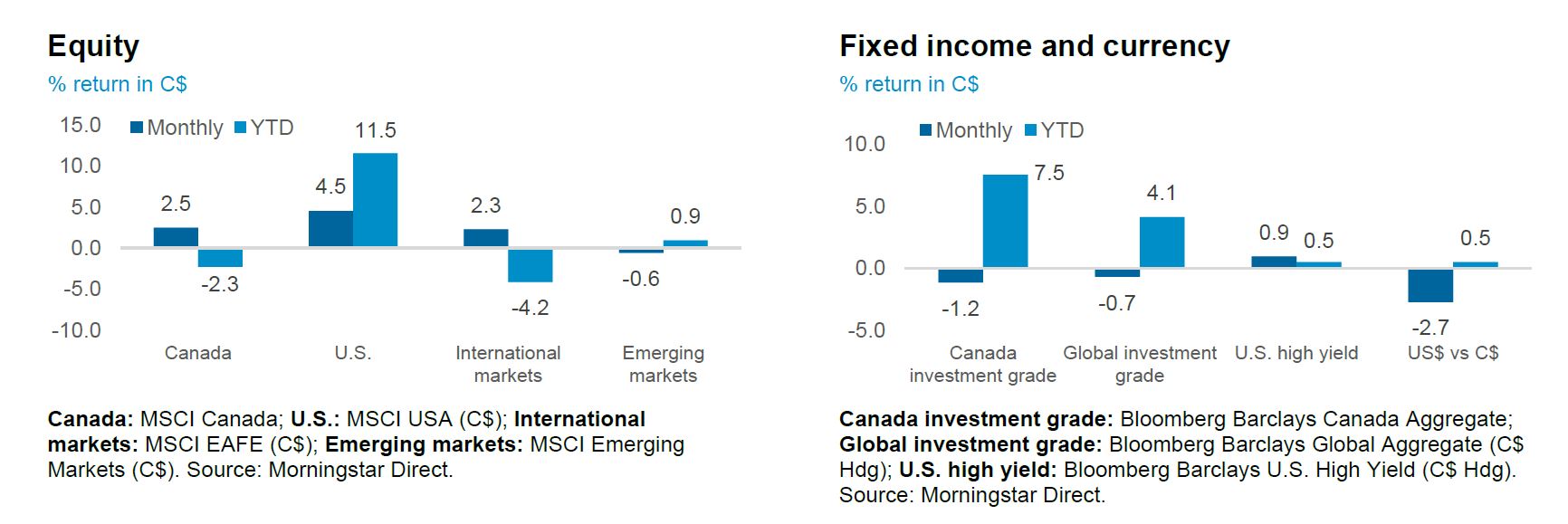Monthly Market Insights - Data and opinions as of August 31, 2020
Global stocks reach new all-time high
Strong activity across business and consumer segments of the global economy pushed stocks (as represented by the MSCI World Index in U.S. dollars) to reach all-time highs. While second quarter GDP show developed economies have contracted between 30-60% on a quarter-over-quarter annualized basis, early third-quarter data suggest the recession may already be over. That said, it is not clear whether the current pace of recovery can be sustained beyond the initial bounceback. Economies cannot fully reopen while the virus continues to spread, which means further stimulus measures will be needed to support displaced small businesses and individuals.
The NEI perspective
Stocks reach record high. The MSCI World reached new all-time highs in August, fueled by strong economic data including Purchasing Manager indices, industrial production, and retail sales in the U.S., Canada and the U.K.
Recovery showing signs of slowing. Economic momentum appears to be peaking with positive surprises beginning to flatten out. With the virus still raging on, this raises questions about whether the initial V-shaped bounce can be sustained as there is clearly a need for further fiscal action.
Continued caution. While U.S. virus cases are finally declining, European countries are now seeing a resurgence after reopening much of their economies. U.S.-China tensions persist, and U.S. elections are just over two months away.

As of September 2020
Markets and U.S. elections
As if investors were not faced with enough headlines this year, 2020 is also an election year in the U.S., and November is only two months away. Based on CNN’s Poll of Polls, Democratic candidate Joe Biden leads with 51% support, compared to 42% for President Donald Trump. This has been a tumultuous year for Trump, as his administration faces increasing criticism for its pandemic response, plus having to deal with the worst U.S. recession in modern times. What’s more, history is not on Trump’s side. While three-quarters of incumbent presidents have been re-elected, data shows that when there is a recession or a market drop of 20% or more during an election year, the incumbent party has lost in all five instances.
The victor will be burdened with the daunting task of guiding the nation’s recovery efforts as well as setting long-term policies. This all has important market implications. Conventional wisdom suggests that Republican presidents, given their pro-busines stance (i.e., lower taxes, free markets) would be more favourable for markets compared to Democrats, who generally favour higher taxes and increased government regulation. History, however, demonstrates otherwise. The chart below shows cumulative stock market gains during Democrat (blue) and Republican (red) presidencies. On average, Democrats have seen annual returns of 10.4%, compared to only 1.9% for Republicans (including Trump’s term to date).
Stock market performance during U.S. presidential terms
Cumulative price return of the S&P 500 (in U.S. dollars)

Source: Bloomberg. Data as of August 31, 2020. Presidential term starts on inauguration day. Cumulative returns reset with each new incumbent.
